| |
|
Friday, May 9 Israel at 60 talk by Eyal Dagan

Sunday, May 18 Community Israel Independence CelebrationWednesday, May 28 JFS~Ellen Saks lecture on mental illness

LETTER FROM JERUSALEM
Palestinian choice: delusions or own state
By Ira Sharkansky
 JERUSALEM—Someone out there should convince the Palestinians that their side lost the wars of 1948 and 1967. Moreover, they did not score a stunning victory in the first intifada 1987-93. Currently some of them are threatening to begin a third intifada. That suggests that the second is finished. If so, it passed without any Palestinian success. Some might claim that it is still on, with the IDF having to add nightly to its stock of more than 11,000 prisoners, and keeping the people of Gaza on short rations. JERUSALEM—Someone out there should convince the Palestinians that their side lost the wars of 1948 and 1967. Moreover, they did not score a stunning victory in the first intifada 1987-93. Currently some of them are threatening to begin a third intifada. That suggests that the second is finished. If so, it passed without any Palestinian success. Some might claim that it is still on, with the IDF having to add nightly to its stock of more than 11,000 prisoners, and keeping the people of Gaza on short rations.
We do not want to educate Palestinians about history for the sake of Israeli bravado, but for the sake of Palestinians' future. Until they accept reality, they will not achieve a state, or significant control over their own lives.
 Why is it necessary to make this clear now? Why is it necessary to make this clear now?
Mahmoud Abbas is complaining to President Bush that the Israelis are not willing to begin discussions from the borders that existed prior to the war of 1967. He said that the Palestinians need help in pressuring the Israelis if there is to be an agreement before the end of the Bush presidency. Reports are that Bush did not give Abbas what he wanted.
Perhaps we should view it as a Palestinian concession that Abbas is not demanding a return to the allocations for Jewish and Arab states that the United Nations indicated prior to the 1948 war. Prime Minister Olmert is quoted as telling Abbas that the Palestinians can forget everything on Israel's side of the security barrier that Israel is building. Much of that is close to the 1967 line, but on the Palestinian side; and it encompasses the major Israeli settlements built since then.
Abbas also says that he cannot give up the right of refugees to return home.
He is on a yellow brick road; not a path to peace.
In terms of territory, Abbas is saying that he is willing to concede to Israel, at most, three to four percent of the Palestinian West Bank. He is saying that Olmert is willing to grant, at most, 65 percent of the Palestinian West Bank; insists on Israeli control of the Jordan Valley and Jerusalem, with provisions for Palestinian autonomy in parts of Jerusalem.
There is likely to be some wiggle room in these details, but the reality is that Palestinians have not done well when they threaten, or embark on violence. They succeed in killing Israelis, but usually lose more of their own people, and end up losing more of the land that they say is theirs.
Hamas is not doing any better in Gaza. After Israel rejected the cease fire that Hamas claimed to draft along with Egypt, it is saying that it is not a Hamas proposal. It is an Egyptian proposal, which Hamas will consider only after Israel has accepted it. Moreover, Hamas has hardened details of the offer since they first became public. It also proclaims that if it decides to accept the Egyptian proposal, its move will only be tactical and temporary. It will not give up the goal of destroying Israel. If Israel rejects the Egyptian proposal, it will suffer the consequences.
Goody. The proud people in charge of Gaza must be satisfied that they have electricity a few hours a day, and enough gasoline for 20 percent of their vehicles. They enjoy watching Israeli tanks in their streets. They like walking in the heat and hitching rides on donkey carts. We will rely on the United Nations to assure that the donkeys have enough to eat.
I aspire to a Palestinian state that is run responsibly alongside of Israel. It should prevent Palestinians from terrorizing one another and the Israelis, and provide decent levels of social services. I doubt that a Palestinian state will exist until the Palestinian leadership accepts the reality of its mistakes, and the weakness that has resulted from those mistakes. They cannot turn back the clock that has been running through several waves of Palestinian violence over the course of six decades. If their expectations and demands are much greater than Israelis are willing to concede, they will not get an agreement, their own state, and a decent future for themselves as a nation.
We should not expect the Palestinian leadership to approach Israel on their knees. Arabs have pride.
Israel will make concessions. Good sense also demands that Israel minimize its efforts at self-defense in order to avoid exerting so much pressure on the Palestinians that they erupt in yet another wave of violence, no matter how futile.
Negotiators can maintain their pride, but they must remain within the range of what is likely.
Palestinians negotiating with Israel must perceive what is possible, and persuade their people about the wisdom of accepting it. They cannot erase 60 or 40 years of failed efforts at violence.
The essence of warfare is that fighters aspire to hold what they can take, or hold onto what they are defending. The essence of politics is to seek what is possible. As the Prussian soldier and theorist Carl von Clausewitz wrote 180 years ago, war and politics resemble one another, except that politics is far less costly for the participants than warfare. And in politics done with skill, no one loses everything.


FROM THE SIDELINES
How Israel at 60 differs from Israel at 50
By Rabbi Dow Marmur
 JERUSALEM—I wrote the following for a the journal of the Dutch Progressive movement, but as I’m about to wrap up my comments on events in Israel for this “season,” prior to returning to Toronto, it occurs to me that the piece may be of interest also to others. JERUSALEM—I wrote the following for a the journal of the Dutch Progressive movement, but as I’m about to wrap up my comments on events in Israel for this “season,” prior to returning to Toronto, it occurs to me that the piece may be of interest also to others.
Sever Plotzker, an Israeli journalist writing in the mass circulation daily Yediot Achronot on the eve of Israel’s Independence Day last year, invited his readers to think back ten years, when Israel was not even 50. He asked rhetorically if they could even imagine what has happened in the country in the last decade. He brought many examples which I’m happy to paraphrase. For what was true a year ago is also true today, even though the actual figures may have changed a little.
In the last decade Israel has experienced a repetition of two of its previous wars: the second intifada and the second Lebanon war. Neither has enhanced Israel’s position in the world or made it more secure. Yet, during the last ten years the country’s population has grown from 5.5 million to 7.2 million. Seventy percent of those who live here say they’re satisfied.
There’s much to suggest that aliyah from the West, particularly among the young, will increase now when immigration from the former Soviet Union has ebbed. We now also speak of partial aliyah, i.e., Jews from the United States and Europe having second homes here and spending extended periods of time in Israel.
 In the last decade Israel has had five governments, six prime ministers and seven ministers of finance. The country’s inadequate political leadership is an embarrassment. Yet, in the same period more than fifty billion dollars have been invested here by foreigners. Politicians may not be trusted, but businesspeople are. Even as we’re bracing for a new world-wide economic downturn, Israel seems to be in a better position than most countries. In the last decade Israel has had five governments, six prime ministers and seven ministers of finance. The country’s inadequate political leadership is an embarrassment. Yet, in the same period more than fifty billion dollars have been invested here by foreigners. Politicians may not be trusted, but businesspeople are. Even as we’re bracing for a new world-wide economic downturn, Israel seems to be in a better position than most countries.
This, of course, doesn’t mean that poverty has been reduced. On the contrary; the number of people living below the poverty line is staggering. But that happens, I’m told though I don’t pretend to understand it, in all wealthy countries. Hence the many poor people in the United States and elsewhere.
There are 45 percent more cars now on Israel’s roads than a decade ago, but 25 percent less traffic accidents, even though the fatalities and injuries are still horrendous – much greater than in all wars. Thirty million passengers travel by train each year within the country. That number is likely to grow in years to come, especially as roads become more and more congested.
Oil has gone up from ten dollars a barrel to one-hundred-and-twenty. Yet, the national debt ten years ago was seventeen billion dollars. Now Israel has a surplus of perhaps around forty billion. Israeli high-tech companies earn annually some 150 billion dollars worldwide.
Two seasoned generals who became Prime Ministers did the unexpected, perhaps the unimaginable: Ehud Barak took Israel out of Lebanon and Arik Sharon took Israel out of Gaza. Yet, peace is more elusive than ever. For all the various initiatives on the table, most Israelis are skeptical; they brace themselves for more of the same, or worse. The best one can hope for is that those in power will know how to manage the crises, even as they’re unable to solve them.
I wrote this before the latest peace efforts: continued negotiations between Olmert and Abbas; something that looks like a truce with Hamas, starting in Gaza and moving beyond (although that’s now being thwarted); better relations with the Gulf States; and, of course, rumors about ceding Golan to the Syrians for peace. Though it doesn’t feel like peace here, who are we to ignore the prospects?
The country has now half-a-million more poor citizens than it had a decade ago. Yet, right-wing parties (ostensibly favoring the rich) have never been more popular than now, whereas left-wing parties (the champions of the poor) have never been so much down-in-the-dumps as now.
The average per capita income is around $22,000 and inflation down to not much above zero. Shekel interest rates are higher than dollar rates. Output is about 70 billion dollars a year. Yet, though the country is in good shape, and most Israelis want to stay, the economic morale is low. The rich are getting richer – 19 families earn a third of Israel’s economic output – while the poor are getting poorer.
Had Plotzker had an interest in Liberal/Progressive/Reform Judaism he would have pointed to the growing recognition of our movement in the country and the growth of its institutions. At least one congregation has even received state money for its building. But the grip on the country of the ultra-Orthodox Shas party has tightened while the Progressive movement is facing near-bankruptcy because Reform Jews the world over don’t support it sufficiently.
The Progressive movement is about to have another national good news-bad news convention: much progress will be reported in many areas and, at the same time, the dire financial situation will be exposed. The latter may lead to staff layoffs and other measures that will easily wipe out the progress.
Plotzker remarks that the mood of the people here vacillates between depression and craziness. Yet virtually every Jew agrees that the establishment of Israel is the most important event in Jewish history since biblical times. His survey bodes well for Israel’s future. In the midst of the vacillating confusion, we can look forward with hope, even confidence, to the next sixty years and beyond – as long as we’re prepared to remain crazy and depressed at the same time.
I surmise that the many pieces I wrote in the last four-five months were marked by confusion as they hovered between depression and hope. I believe that they reflected not only my own neuroses but also Israeli realities. Only those with preconceived ideas and outdated ideologies are able to report on Israel without contradicting themselves.

THE JEWISH CITIZEN 'A Jewish Story Everywhere'
La Mesa developer saw 'Promised Land' from the heights of his own Mount Nebo
Hashem spoke to Moses on that very day, saying, “Ascend to this mount of Abarim, Mount Nebo, which is in the land of Moab, which is before Jericho and see the Land of Canaan that I give to the Children of Israel as an inheritance, and die on the mountain where you will ascend, and be gathered to your people, as Aaron your brother died on Mount Hor, and was gathered to his people because you trespassed against Me among the Children of Israel at the waters of Meribath-kadesh, in the wilderness of Zin; because you did not sanctify Me among the Children of Israel. For from a distance shall you see the Land, but you shall not enter there, into the Land that I give to the Children of Israel. —Deuteronomy 32:48-52:
|
By Donald H. Harrison
 LA MESA, California—Sherman C. Grable, a Methodist from Ohio who evidently knew his Hebrew Scriptures quite well, purchased hundreds of acres of land here in 1906 and decided thereafter to offer to potential settlers a view that the Prophet Moses might envy. LA MESA, California—Sherman C. Grable, a Methodist from Ohio who evidently knew his Hebrew Scriptures quite well, purchased hundreds of acres of land here in 1906 and decided thereafter to offer to potential settlers a view that the Prophet Moses might envy.
Wonderful view lots were on a hill that rose 300 feet above the table land that was to become known as La Mesa, but which originally was named "Allison Springs," after settler Robert Allison, and later " La Mesa Springs."
Somewhat grandiloquently, Grable named this hill “Mount Nebo” after the summit up which Moses trudged at God’s command to look out upon Canaan and then to be gathered up to his people. Grable’s hill would have needed to grow nearly another half mile in height to match the size of the famed Biblical mountain (2,680 feet) on the Israel-Jordan border, but nevertheless Grable saw from it a panorama that he apparently considered as filled with potential as the Promised Land.
In fact, he could survey from his mountain a nearby area known today as Collier Park (honoring an earlier pioneer, D.C. Collier) and see the spring that was the namesake for Allison Springs/ La Mesa Springs as well as the reason why the San Diego and Cuyamaca Railroad already had located a station below his mountain.
In 1908, two years after purchasing and subdividing his mountain, Grable and partner C.C. Park published the first edition of La Mesa Scout as a way to draw attention to the lots which he sold for $200 if they had a view and $150 if they were on level ground.
“As we leave the Spring Valley station on the Cuyamaca railroad, our attention and admiration are attracted by the wonderful scenery…” wrote the Scout’s first editor, Wiley A. Magruder. “ At last we stop, and alighting from the train, we are conducted to a carriage bound for the summit of that majestic sentinel, Mount Nebo.”
Running short of adjectives, Magruder challenged his readers: “Our own vocabulary was exhausted long ago in the vain searching for an expression that will carry what we mean. To the person or persons who will send in such an expression as will convey something of the feeling one has when he stands upon the summit of Mount Nebo in Lookout Park, we will give a free year’s subscription to this paper.”
Anna M. Gilbert, who in 1924 authored the local history, La Mesa Yesterday and Today, was many years too late for Magruder’s contest, but nevertheless she waxed lyrically: “All around La Mesa are beautiful views and beautiful country but none this side of Grossmont and Helix can surpass that seen from the top of Mt. Nebo. From there ridges of blue-clad mountains can be seen to the north, south and east, while to the west in Point Loma and the bay. At night the lights of San Diego are an added beauty when looking westward.”
Gilbert also recounted a train ride taken from their offices in downtown San Diego to their homes in La Mesa by two town pioneers, Colonel James J. Randlett, a former Civil War scout, and Dr. Parks. They were sitting in the caboose of the mid-day train when “Col Randlett looked out toward Mt. Nebo and seeing the furrows marking off the lots, and the streets plowed, he said: ‘What in the world is Grable doing now?’ Dr. Parks replied ‘Grable expects a street car line to be running to the top of Mt. Nebo in a few years.’ Col. Randall then asked ‘Do you think this place will ever amount to anything?’ Dr. Parks answered that was brought him here and that his belief in La Mesa was unbounded.”
How Mt. Nebo appeared from the town site is shown in the photograph above taken in 1911 of a U.S. Army contingent riding through town. The hill is practically barren although here and there one can see some of the early homes that today are historic landmarks in La Mesa.
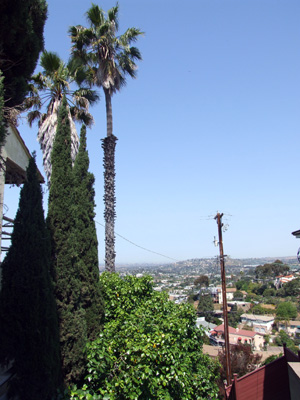 
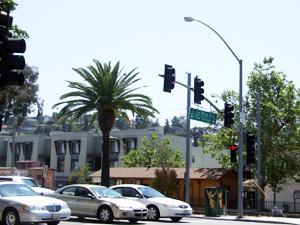 
Much has changed since that historic photograph was taken. Today, the hill is covered with houses and vegetation and the downtown area bustles with businesses—obscuring views in both directions. Lookout Avenue now is called La Mesa Boulevard. Date Avenue retains its name, but Third Avenue and Railroad Avenue respectively have added to the biblically reminiscent flavor by becoming Acacia and Nebo Avenue.
“Mt. Nebo,” “Acacia,” “Date”—one might get the impression that La Mesa residents wanted their town to be considered a biblical paradise. However, promoters of the area, including Grable himself, also chose other names to invoke images of gracious living. Promotional material for Grable’s hillside development suggested that La Mesa was to San Diego what the tony suburb of Pasadena was to Los Angeles. The comparison so resonated that one of the important streets on Mount Nebo indeed is Pasadena Avenue, not the first time a real estate developer has mixed a metaphor. Developers of nearby property were equally enamored of the Britain of legend, bestowing such street names as Windsor and Canterbury in a section of Mount Nebo dubbed Windsor Hills.
In addition to its views, another distinguishing characteristic of the Mount Nebo neighborhood are the “secret stairs” that rise between home lots from lower streets to Summit Drive. Driving around the neighborhood recently, I saw a shirtless athlete huffing up the 245 steps to Summit Drive from Windsor and Canterbury Drives. As he caught his breath at the top of the stairs, I asked how good a workout the run up had been. “Brutal!” he gasped.
Grable had his large 2 ½ story home, which he named “Hillcrest, ” built at the end of Date Avenue. Another picturesque neighborhood spot is Prospect Way, where La Mesans held Easter Sunrise Services in 1915 before the area’s landmark concrete cross and amphitheatre was built on Mount Helix.
 |
Balloon Utopia
Sandi Masori
619 339 8024
 |
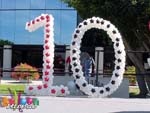
! |
 |

REFLECTIONS
Klezmer - Jewish music for your soul
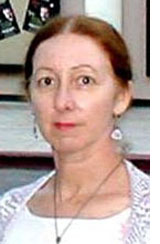 SAN DIEGO—One afternoon in the mid 1990’s I happened to turn on KPBS and there filling the screen was the face of renowned violinist extraordinaire, Itzhak Perlman, his brows furrowed (more than usual), but with a whimsical smile on his lips. Furiously bowing his violin the music flowed, but it was not the usual Bach, Brahms, or Beethoven; it was klezmer. That was more than enough to keep me fastened in my chair for the next hour or more. Watching Perlman “struggle” (his words) and his smile as the music swirled around, was a study in genius at work. SAN DIEGO—One afternoon in the mid 1990’s I happened to turn on KPBS and there filling the screen was the face of renowned violinist extraordinaire, Itzhak Perlman, his brows furrowed (more than usual), but with a whimsical smile on his lips. Furiously bowing his violin the music flowed, but it was not the usual Bach, Brahms, or Beethoven; it was klezmer. That was more than enough to keep me fastened in my chair for the next hour or more. Watching Perlman “struggle” (his words) and his smile as the music swirled around, was a study in genius at work.
Klezmer to me has always meant a wedding or a bar/bat mitzvah - lots of happy people, food to eat and a big circle of clasped hands, and grapevine stepping feet (a pas de bourrée degagé in ballet terms). Klezmer today can mean that, but it also means a theater, a concert, rows of seats and happy people. Even the sad songs are somehow - happy.
Klezmer gradually grew up through the last few centuries out of folk tradition; a secular form of music of a religious people. It brought together many strands from other cultures through which Jews traveled and within which they lived. If one listens carefully one can hear a gypsy motif, Hungarian, Polish, Russian, Ottoman and other Middle Eastern influences as well as Jewish cantorial music from the liturgy.
Originally the instruments were mostly string or the softer woodwinds like the flute (originally made of wood) and the reeds. The louder, brassier instruments such as trumpet were forbidden to Jews - especially in Russia. Why this was deemed to be a threat to the general population is a mystery. Instruments such as the clarinet came later when restrictions were lifted by the “liberal” Tsar Alexander II.
The program I saw on KPBS in which Perlman was playing violin included four groups - among them the Klezmatics. As soon as the CD was available I bought it. Some of the instruments used in klezmer are: coronet, tambourine, bass, trombone, flute, piccolo, alto saxophone, accordion, piano, guitar, violin, drums, timpani (mallet instruments), clarinet, banjo, xylophone, flute, dulcimer and mandolin.
I play my CDs as I work at my craft table (building from scratch a doll house, cutting out coupons for the military and knitting Linus blankets), and it makes me happy. I play the CDs when I am sad, and it makes me happy. I play them when I am happy and it makes me happier. Even when telling a sad story in musical terms, Klezmer ends up making it happy. Barring a full blown tragedy, it is hard to imagine remaining sad - or neutral - when listening to klezmer.
Therefore, when I received a notice that the Klezmatics were going to perform in San Diego last fall, I made a mental note not to miss it and spent the intervening days listening to my prized CDs - getting psyched up. Unfortunately, because of the wild fires which raced around San Diego County the performance was cancelled. It was re-scheduled as part of the Jewish Musical Festival and I attended the April 24 performance at the Birch North Park Theater.
First let me make clear - I am not a music critic in any sense - not technically, or historically and certainly not an authority of any kind on klezmer. But it doesn’t take an authority to immediately realize that this group of six musicians is marvelously talented. After all, Perlman wouldn’t have performed with some schlock group. I trust his taste. And it tasted good.
As a dance critic it is of interest to me to note that there is a dance connection with klezmer. One of the members of the Klezmatics mentioned from the stage that they had performed with the Pilobulus Dance Company - a group which pushes the boundaries of modern dance movement. Also, back in 2002 I had seen and reviewed (for another site) a San Diego Ballet performance of classical choreography in tutus and pointe shoes specifically created for klezmer - and it worked.
Each of the musicians - except perhaps the violinist (she “only” played the violin on stage) plays several instruments; occasionally at the same time. One in particular played a brass horn with one hand and a keyboard instrument with the other. One can only imagine the electrodes firing off in his brain! And they all sang, too - including the drummer. Watching him have fun with all the drums and other tympanic instruments made me envious; I would LOVE to get up there and bang away on the drums for a while. His body was “loose as a goose” as he struck out, drummed, hit this cymbal, thumped another and obviously had a wonderful time of it.
Well, they all did - and so did we. The songs were in Yiddish and/or English and for the most part unfamiliar to me. However, they finished up with one I did know from the CD and the lyrics were simple enough even for the likes of me to sing: “Oy, yoy, yoy - Oy yoy, yoy” - to a wonderful bright very un-oy-oyish melody. The audience was standing, clapping and happily oy-yoy-yoying. Kinda like Jewish yodeling, I suppose.
I loved it from start to finish. However, I would have liked a couple of familiar Jewish songs and certainly at least one round of “Hava Nagila.” Yes, I know that’s trite - but there it is. The group seems to be taking the music to new territory and eschewing the old. However, as a number of dance companies have discovered a bit of the “old” helps the audience digest something “new.”
Unfortunately, no program notes were provided and thus no names of the band members or titles of songs, composers, etc.
If the Klezmatics come your way - go and get in their way - and enjoy.
Beth Jacob Congregation to build on Thirtieth Street Site
From Southwestern Jewish Press, August 1949, page 1
Final plans have been drawn for the new building which will be built to house the Beth Jacob Congregation and center on their newly acquired lot on 30th Street. The proposed building will have a synagogue which will conveniently accommodate 350 people, as well as an Auditorium and a number of classrooms for the Religious and Sunday School classes.
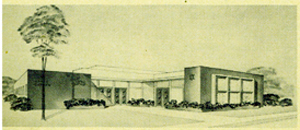 Every effort is being made by the Building Committee, headed by Morrie S. Kraus and Ralph Hosepud, to start construction on the building by mid-September. Every effort is being made by the Building Committee, headed by Morrie S. Kraus and Ralph Hosepud, to start construction on the building by mid-September.
Mr. A. Abramson, President of the Congregation, announced that High Holiday Services this year will be conducted in the Vasa Club, located at 3094 El Cajon Blvd. The congregation felt the need for an enlarged place for services to enable all the people who so desire, to comfortably observe these most important Holidays of the year.
The ticket sale for seats will start at once, and reservations are being accepted by mail to 3206 Myrtle Avenue or by phone by calling Randolph 1706. At a date to be specified later, there will be a representative on the premises of the Congregation daily with whom reservations for seats can be made.
Rabbi Barcuh Stern, spiritual leader of Beth Jacob Congregation, will officiate at the services, which will start at sundown on September 23.
Congress Chapter Inaugurated Here
From Southwestern Jewish Press, September 1949, Page 4
A new American Jewish Congress chapter is being formed in San Diego. Members of the community interested in the work of the Congress met at the home of Mr. and Mrs. A. Louis Solof Thursday, August 25. Rabbi Leonard A. Greenberg of Los Angeles, Pacific Coast field representative of the A.J.C. led discussion on A.J.C. claims and philosophy.
Rabbi Greenberg introduced Mel Springer, publisher of the Valley Jewish News, North Hollywood, chairman of the Southern California administrative committee, as guest speaker, who told of the forming of Congress 33 years ago by Rabbi Stephen S. Wise and Louis Lipsky and of its steady progress to the present day.
“For the past eight years A.J.C. has taken a more active and militant stand on discrimination, Springer said, leading the way for other American groups. Through its Law and Social Order program, the Congress has attacked anti-semitism from a constructive angle, fighting this scourge through the courts when necessary. Assuming that discrimination is in reality an attack on democracy, its legal department is ready to champion minority groups of all colors and creeds, banding together for protection against bigotry at all times.
Springer told the group of the exceptional educational program; its Office of Jewish Information, which publishes “Jewish Affairs,” a bi-monthly; the “Congress Weekly,” outstanding Jewish publication, edited by J.L. Teller, former editor of the Independent Jewish Press Service.
A.J.C. worked untiringly for the realization of the state of Israel, and is now concentrating on the denazification program in Germany, which is taking an alarming turn.
During the past few years many chapters have been formed throughout the nation. In California, Los Angeles leads with thirty-five active chapters, san Francisco and San Jose have recently joined the region, which is headed by Judge Ben Rosenthal and Rabbi Max Nussbaum of Los Angeles.
Meeting at the Solof home were: Mr. and Mrs. Lewis Solomon, Mr. and Mrs. Louis Pollack, Mr. and Mrs. Milton Roberts, Mr. and Mrs. Wm. Schwartz, Mr. and Mrs. Harry Wosk, Hillel Arkin, Mrs. Eva Arkin, Raymond Bass, Oscar Dubowsky, Henry Price, Morrie Douglas, Manny Haffner and Dr. Walter Ornstein. The group set up a steering committee headed by Lou Pollack to plan a public meeting for the immediate future.
Beth Israel Introduces New Cantor
From Southwestern Jewish Press, September 1949, page 13
Beginning with the High Holy Days this year, Cantor Julian K. Miller, who will co-officiate at all temple Beth Israel worship services throughout the year, will sign and lead a choir at these services.
Professor Miller, one of the outstanding cantors and Jewish musicians in America, formerly held a position on the musical faculty of Michigan State College. He holds the academic degrees of B.SC, M.Sc., B. Mus., and M. Mus.
Formerly the cantor and director of music at K.A.M. Temple in Chicago, Cantor Miller has performed with the Chicago Civic Opera Company, the Chicago Theatre of the Air, as well as having been program director of Radio Station WILS in Lansing, Michigan.
Institute Classes Open On Oct. 12th
From Southwestern Jewish Press, October 1949, page 4
Dr. A.P. Nasatir, Dean of the Institute of Jewish Studies announces that classes will officially begin on Wednesday, October 12th at 7:45 p.m. at the temple center, 3rd and Laurel Streets.
Classes offered are: Beginning and Advanced Hebrew, History of Jewish Phylosophy (sic, Philosophy), Yiddish Literature, Biblical Literature, American Jewish History, Jewish Marriage and the Family, “What’s Cooking” in Judaism and Great Jewish Books.
The Institute is in its second year. Members of the Faculty are Rabbi Morton J. Cohn, Rabbi Monroe Levens, Rabbi Baruch Stern, Dr. A.P. Nasatir, Mrs. A. Neumann, MRs. Harris Rubel, Mr. Isaac Domnitz, Dr. Harry Ruja, MR. Al Hutler and Mrs. {Ida} Nasatir.
Adult Jewish Studies are sponsored by the Jewish Education Commission of San Diego.
Welcome Home
From Southwestern Jewish Press, Nov. 14, 1949, page 1
It was good to learn that Federal Judge Jacob Weinberger has been appointed to serve as resident Federal Judge in San Diego.
The Jewish Community has sorely missed the leadership and wise council of Judge Weinberger during his absence {in Los Angeles}.
We are looking forward to having Judge and Mrs. Weinberger in our midst again.

SAN DIEGO JEWISH WORLD THE WEEK IN REVIEW
Judy Lash Balint in Jerusalem: A Jerusalem sight not to be passed over
Shoshana Bryen in Washington, D.C.: Why is Olmert discussing Golan Heights?
Rabbi Baruch Lederman in San Diego: Chofetz Chaim Yeshiva leader Rabbi Henoch Leibowitz, ztzl, had spiritual magnetism
Rabbi Dow Marmur in Jerusalem: Is Kadish kaddish for Pollard's freedom?
Rabbi Leonard Rosenthal in San Diego: Minyan prayer for 3 kidnaped soldiers
Ira Sharkansky in Jerusalem: Political smoke in the Israeli winds
Adventures in San Diego Jewish History: The Southwestern Jewish Press in July 1949 printed articles detailing the histories and purposes of various Jewish organizations in San Diego. We reprint some of them here.
Shoshana Bryen in Washington D.C.: Syrian-Korean nuclear program mysteries
Gerry Greber in Carlsbad, California: Is afikomen needed if end-product near?
Rabbi Dow Marmur in Jerusalem: Syrian-Israeli peace: genuine offer from President Assad or just a cynical ploy?
Sheila Orysiek in San Diego: Chapter Five in the serialization of her novel, Reluctant Martyr
Adventures in San Diego History: The Southwestern Jewish Press in July 1949 printed articles detailing the histories and purposes of various Jewish organizations in San Diego. We reprint some of them here.
Carol Davis in Carlsbad, California: A 'Kiss' that completely shook their world
Donald H. Harrison in San Diego: And what if you are wrong, Jimmy Carter?
Sheila Orysiek in San Diego: Confidence counts; kindergarten counts
Hal Wingard in San Diego: Two songs--'Oh, Jerusalem' and 'The Wisdom of Chelm'
Adventures in San Diego History: The Southwestern Jewish Press in July 1949 printed articles detailing the histories and purposes of various Jewish organizations in San Diego. We reprint some of them here.
Shoshana Bryen in Washington, D.C.: Hamas made a goat of Jimmy Carter
Donald H. Harrison in San Diego: Book on Golda Meir trashes Shimon Peres
Rabbi Dow Marmur in Jerusalem: Israel's brightening diplomatic picture
Adventures in San Diego History: The Southwestern Jewish Press in July 1949 printed articles detailing the histories and purposes of various Jewish organizations in San Diego. We reprint some of them here.
Ulla Hadar in Sha'ar Hanegev, Israel:Rocket whizzes over head of Mayor
Alon Schuster of Sha'ar Hanegev
J. Zel Lurie in Delray Beach, Florida: Carter is still trying to make peace
Ira Sharkansky in Jerusalem: Clarity is a casualty of Mideast conflict
Adventures in San Diego History: The Southwestern Jewish Press in July 1949 printed articles detailing the histories and purposes of various Jewish organizations in San Diego. We reprint some of them here.
< BACK TO TOP
|
|

 —
—